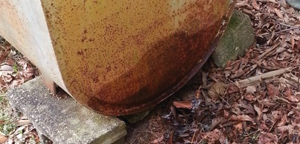Signs Your Heating Oil Tank Needs To Be Replaced
Even the best oil tanks won’t last forever. How do you know when it’s time to replace your home heating oil tank? While other types of equipment can be fixed before replacements are necessary, oil tanks are different. Oil tanks typically cannot be repaired, so it’s best to replace yours when the time is right. So how do you know when it’s time for a new tank?Even the best oil tanks won’t last forever. How do you know when it’s time to replace your home heating oil tank? While other types of equipment can be fixed before replacements are necessary, oil tanks are different. Oil tanks typically cannot be repaired, so it’s best to replace yours when the time is right. So how do you know when it’s time for a new tank?
Signs That It's Time To Replace Your Heating Oil Tank:

Age of your tank
The average oil tank has a lifespan of about 15 years. As your tank ages, the risk of a costly oil leak increases. Although you may not notice other signs of deterioration, there could be internal weak spots or damage inside your tank as it gets older that could cause it to leak.

Rust and wet spots
Rust on the outside of our tank could be an indicator of weak spots in the walls of your tank. If the inside of your tank starts to rust, it could create a build-up of sediment on the bottom of your tank that can lead to clogged lines.

Leaning or missing legs
If the legs of your tank have gotten weak and it has started to lean, it is time to replace your tank. A collapsing leg on an old tank could easily cause a break in your tank resulting in a costly leak. Your tank should also be evenly supported on all four legs, without using blocks or other means of support.

Signs of a prior leak
If there are wet spots or stains on or around your tank, there is a good chance your tank has leaked in the past. Prior leaks indicate that there could be weak spots in the seams or walls of your tank, which could lead to more leaks in the future.

Fill and vent pipes are different sizes
If your fill and vent pipes are different sizes, it's possible that your tank cannot ventilate properly when being filled. Without proper ventilation, pressure can build up inside your tank and cause your seams to weaken, or can even cause your tank to burst.
How Long Does An Oil Tank Last?
The Maryland Department of the Environment recommends replacing your oil tank about every 15 years. If your tank is older than 15 years, it may be at risk for a potential leak that could cause environmental harm, among other problems. Oil leaks are very costly, but proactive replacement at the end of your tank’s life is the easiest and best way to prevent an expensive oil leak in your future.
If an oil tank leaks, the cleanup and any liabilities associated with the leak are the responsibility of the homeowner. Environmental cleanup is required to remove any oil from the surrounding soil, and can cost anywhere between $10,000 and $50,000 for an above ground tank.

Why Do Oil Tanks Leak?
Sludge naturally forms and settles at the bottom of and oil tank its lifetime, This sludge is a collection of water and sediment that occurs naturally during the process of heating fuel oil. Even in a brand new tank with the cleanest oil, an accumulation of sludge will build up in the tank.
Normally this buildup only becomes a problem after years of use. The settlement of sludge over many years rusts the tank from the inside out, creating a risk for oil leaks. Since the rust occurs on the inside of the tank, you may not notice anything is wrong until the oil is already leaking. By then, you may be in for some expensive surprises.
If there are wet spots or stains on or around your tank, there is a good chance your tank has leaked in the past. Prior leaks indicate that there could be weak spots in the seams or walls of your tank, which could lead to more leaks in the future.
Proactive replacement BEFORE your tank leaks is the safest and most cost effective way to replace your tank. For a more in-depth review of the condition of your tank and a free estimate, contact us to have one of our representatives contact you to schedule your FREE in-home consultation.
What Will Happen If I Choose Not To Replace My Oil Tank?
As water, sediment, and sludge accumulate at the bottom of your oil tank, your furnace or boiler could experience problems from contaminants entering the system. As this occurs, you may notice:
- A loss of heat during a critical time of need.
- Multiple equipment breakdowns leading to service calls and repairs.
- Erosion of the burner tips and mechanical parts.

What Are The Benefits of An Oil Tank Replacement?
By replacing your current oil tank now, you can avoid an environmental complication and save thousands of dollars associated with the clean-up of an oil spill. Proactive replacement gives you time to select the best replacement option for you. That way you can choose the most efficient unit to save on your energy bills, as well as add to your home’s resale value.
Oil Tank Replacement With SMO Energy
SMO Energy offers a number of affordable options for home heating oil tank replacement as well as 0 percent in-house financing. Visit the SMO Energy site to learn more about new oil tanks like the double wall tank, which provides double the protection. Whether it’s a replacement oil tank or a heat pump, we can help keep your family comfortable all year long while saving money.
